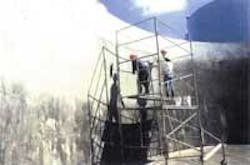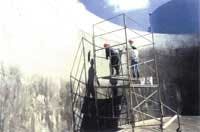Crystalline System Blocks Water Passage Through Concrete
By Leo Connell
Although crystalline waterproofing has been used in Europe and North America for more than 50 years, it is still met with considerable skepticism even today. In fact, many people have never even heard of this method of waterproofing concrete.
The basic idea behind crystalline waterproofing is to prevent the movement of water through the concrete by plugging or blocking the natural pores and capillaries found in all concrete. This stands in contrast to more conventional means of waterproofing, which usually involves applying some sort of coating or membrane to the concrete surface.
In the last 30 years, advancements in this crystalline technology by Canadian manufacturers such as Kryton International Inc. have resulted in it's widespread use.
This integral waterproofing can be installed in various methods, resulting in improved constructability, performance and savings in time and money.
Application
Crystalline waterproofing products are generally supplied as a dry powder comprised of Portland cement, silica sand, and special chemicals. The powder is mixed with water to form a thick slurry. The slurry is brushed onto a prepared concrete surface.
The chemicals contained in the waterproofing compound combine with water to create a chemical reaction. This reaction causes long, narrow crystals to form, which grow in and through the pores, capillaries, and hairline cracks of the concrete mass. The crystals block these passages thus preventing the movement of water.
The chemicals themselves are carried into the concrete by capillary action and diffusion. Capillary action is the natural wicking movement of liquids in a porous structure. Diffusion is the natural movement of chemical molecules. These processes cause the crystals to penetrate deeply into the concrete.
As long as there is moisture present, the crystals will grow many inches, or even several feet through the concrete over a period of days, weeks and months. When moisture is removed, the chemicals will sit dormant, waiting for the next dose of water to begin the reaction again.
The ability of the chemicals to sit dormant and then become active again in the presence of water, gives the treated concrete a "self-healing" ability.
Sometimes new cracks will form in concrete from settling or some other cause. Water entering through these cracks will come into contact with the dormant chemicals and cause new crystals to form and grow to again shut off the water.
Besides its self-sealing properties, crystalline waterproofing treated concrete has additional advantages when compared to conventional membrane systems. Paramount among these is the ability to make the application to the negative side of the concrete – that is, the side opposite the source of the water against the pressure.
To be successful, membranes must always be applied to the positive side of a leaking concrete structure. Unfortunately, it is often impractical or even impossible to access the positive side.
Water tanks, reservoirs, and sewage treatment facilities are typical examples of this situation. Since crystalline waterproofing grows into, and becomes part of the concrete, it makes no difference which side of the concrete it is applied to.
Another important advantage of crystalline waterproofing is its near immunity to damage. Membrane systems often fail when they become scraped, punctured, or torn. Crystalline waterproofing systems, on the other hand, are not affected by these occurrences. Again, because the crystalline waterproofing acts within the concrete, the coating on the surface is not vital.
Since the majority of the active crystalline migrates into the concrete in the first 28 days, the crystalline waterproofing treatment can actually be completely removed from the surface after this time with little effect.
Dry Shake Method
Although crystalline waterproofing had been used for many years as a repair material, it also can be used in new construction. When placing concrete slabs, the dry powder product can be spread onto the setting concrete and troweled into the surface – usually with a power trowel. This application method has become known as the "dry shake method."
Using the product in this way has some advantages over the brush on method: because it is troweled into the surface, the crystalline penetration is immediate; new concrete has a high moisture content, which accelerates the crystalline reaction and crystal growth; and, since it becomes part of the concrete, the surface can be finished smooth.
Integral Crystalline Waterproofing
Following the success of the dry shake method, a further innovation was made to crystalline waterproofing applications in new construction. In the late 1970's, a version of Integral Crystalline Waterproofing was developed to be added right into the concrete mixture before it is placed.
This application method shares the self-sealing and immunity-from-damage properties of the slurry application, along with the advantages of the dry shake method.
Most important, the admixture version eliminates the need to make any kind of surface application at all and it also has benefits in shrinkage reduction, placing and improvements in long-term performance. The cost added to the concrete is more than offset by the savings gained by eliminating the time and the labor that would have been required to apply a product to the surface.
In the last decade, using Integral Crystalline Waterproofing as an admixture has become an accepted replacement for conventional membranes in new construction.
Brand Selection
Once utilities have decided to go with crystalline waterproofing, they are faced with a choice of products from competing manufacturers. Choosing the best one can be problematic.
The literature of one product reads very much the same as another. One must be careful not to confuse crystalline waterproofing products with products that are simply concrete densifiers or pore blockers.
Watch also for products that claim to grow crystals but really only crystallize as they dry. Such products do not grow through the concrete, nor do they reactivate in the presence of water to fill cracks. Products that contain silicates, stearates, or talc are temporary waterproofers at best so manufacturers should offer long-term warranties and they should be able to state that their products are not based on these chemicals.
With all systems in construction, good communication and co-ordination between the manufacturer, specifier and contractor are paramount for total success.
About the Author: Leo Connell, is the Marketing Manager of Kryton International Inc. Vancouver, BC. For more information on Integral Crystalline waterproofing, visit www.kryton.com.
